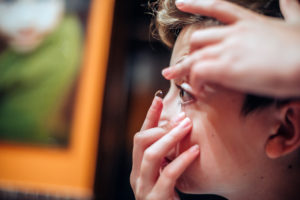sponsored content
June 15, 2023

Carol Yepes, Getty Images
Alexander, a 13-year-old boy who loves playing table tennis, recently faced a major change in his life: his family’s relocation from Quebec, Canada, to the United States for his father’s new job in Miami. While the international move from cold and snow to warm weather and beaches was a significant change for Alexander, one constant for the eighth grader has been his vision.
Over five years, two countries, and one treatment, Alexander’s myopia has remained quite stable. First diagnosed with myopia by his Canadian eye care provider (ECP) at the age of 8, Alexander’s initial prescription was -1.25D when he first started wearing MiSight 1 day soft contact lenses.* Half-a-decade later, Alexander’s prescription has only crept up to -1.75D, representing just a half-diopter change over five years of continuous treatment with MiSight 1 day.1†
Alexander’s Quickly Progressing Myopia Led to This Treatment
Of note, Alexander’s real-world myopia control experience mirrors the findings of a recent peer-reviewed publication that showed age-appropriate children with myopia who wore MiSight 1 day maintained a consistent slowing of myopia progression over a six-year period.1
Alexander’s myopia journey started in third grade when his mother Stephanie took him to see an ECP in their former hometown of Quebec City since he was struggling to see the white board at school. At the time, the family’s Canadian ECP first prescribed single-vision spectacle lenses followed by single-vision contact lenses to correct the young man’s refractive error. “Unfortunately, his vision decreased very, very rapidly on those treatments,” Stephanie recalled.
With the aim to slow down Alexander’s myopia progression, the family’s Quebec City ECP then prescribed MiSight 1 day, which was available to age-appropriate children with myopia in Canada earlier than in the United States. Since Stephanie and her husband Philippe both have myopia, the couple was aware that myopia for Alexander has a genetic component,2 and they didn’t want their son’s vision to continue to worsen. This concern motivated them to immediately get on board with their ECP’s myopia control treatment plan.
ECP Search Led to Nova Southeastern University College of Optometry
“Alexander’s myopia appeared suddenly, and it was rapidly getting worse,” Philippe explained. “We needed to find a solution, and MiSight 1 day slowed the progression.”3‡
When the family first arrived in Miami, they knew they wanted to keep Alexander in MiSight 1 day since he was experiencing positive results over the treatment period thus far. Their search for an ECP who specialized in myopia management and prescribed MiSight 1 day brought them to Nova Southeastern University College of Optometry, where Alexander continues to be a patient.
Daily Disposable Contact Lens Choice Led to Freedom from Spectacles
Another benefit of myopia control: the child-friendly,3 daily disposable soft lens also gave Alexander freedom from spectacles, which he said has been especially helpful when he’s engaged in his favorite activities, including soccer and table tennis.4
“When I played sports, my glasses fell off sometimes, which really frustrated me,” Alexander said.
Alexander also mastered application and removal with ease, even as an 8-year-old.3҂ “At the beginning, it was a little hard, but then I practiced and quickly learned how to do it,” he said.
His advice for other children who are starting out as new contact lens wearers, “Just practice. That’s my only advice. I wear my contact lenses every day, and learning how to wear them is pretty easy.”3
*Indications for use in the U.S.: MiSight 1 day (omafilcon A) soft (hydrophilic) contact lenses for daily wear are indicated for the correction of myopic ametropia and for slowing the progression of myopia in children with non-diseased eyes, who at the initiation of treatment are 8-12 years of age and have a refraction of -0.75 to -4.00 diopters (spherical equivalent) with ≤ 0.75 diopters of astigmatism. The lens is to be discarded after each removal.
† -0.25D or less of change. Lenses fitted between the ages of 8-12 at initiation of treatment.
‡ Compared to a single-vision 1 day lens over a three-year period.
҂ By one month. As reported by parents.
References
- Chamberlain P, Bradley A, Arumugam B, et al. Long-term effect of dual-focus contact lenses on myopia progression in children: A 6-year multicenter clinical trial. Optom Vis Sci. 2022 Mar 1;99(3):204-212.
- Xue-Bi, Shen SR, Chen DF, et a. An overview of myopia genetics. Exp Eye Research. 2019 Nov;188:107778.
- Chamberlain P, et al. A 3-year Randomized Clinical Trial of MiSight Lenses for Myopia Control. Optom Vis Sci. 2019; 96(8)556-567
- Walline JJ, Jones LA, Chitkara M, et al. The Adolescent and Child Health Initiative to Encourage Vision Empowerment (ACHIEVE) study design and baseline data. Optom Vis Sci. 2006;83(1)37–45.













